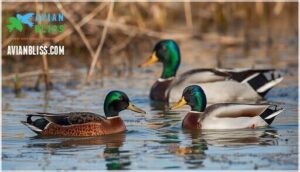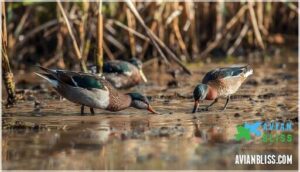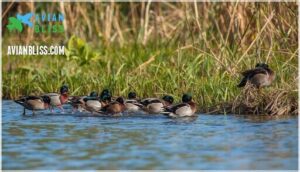This site is supported by our readers. We may earn a commission, at no cost to you, if you purchase through links.

From prairie potholes to coastal estuaries, these agile fliers thrive in shallow wetlands where dense vegetation meets open water.
Understanding their identification features, habitat needs, and seasonal rhythms helps you recognize North America’s smallest dabbling duck whether you’re scanning a winter marsh or watching spring migration unfold.
Table Of Contents
- Key Takeaways
- Green-winged Teal Identification and Features
- Habitat and Geographic Range
- Diet and Foraging Behavior
- Breeding and Life Cycle
- Conservation Status and Notable Facts
- Frequently Asked Questions (FAQs)
- What is the difference between green-winged teal and common teal?
- Where can I find green-winged teal?
- How fast do green-winged teals fly?
- What type of nest does a green-winged teal have?
- Can Green Winged Teals be kept as pets safely?
- How do Green Winged Teals adapt to changing weather?
- Can Green Winged Teals interbreed with other duck species?
- How long do green-winged teals typically live?
- What predators threaten green-winged teal populations?
- How do green-winged teals communicate vocally?
- Conclusion
Key Takeaways
- The green-winged teal is North America’s smallest dabbling duck, at 12-15 inches long and under one pound, yet it flies up to 60 mph and can rocket off water faster than ducks twice its size.
- Males display a distinctive cinnamon head with an iridescent green stripe during breeding season, while females maintain mottled brown camouflage year-round, with both sexes showing a metallic green wing patch called a speculum.
- These ducks thrive in shallow wetlands under 10 inches deep with 35-75% open water and dense vegetation like cattails, breeding primarily in Canada’s boreal forests and prairie potholes before migrating through four major flyways to winter along the Gulf Coast and into Central America.
- Their population has recovered impressively from 722,000 birds in 1962 to approximately 6.7 million today, earning a “Least Concern” conservation status, though climate change threatens a 10-20% decline by 2050 due to wetland loss and altered breeding conditions.
Green-winged Teal Identification and Features
When you spot a duck the size of a crow paddling in shallow water, you might be looking at a Green-winged Teal. These pocket-sized ducks have a distinctive shape and coloring that sets them apart once you know what to look for.
Here’s how to identify them in the field.
Size, Shape, and Measurements
You’ll spot the green-winged teal by its tiny frame and blocky build. This little dabbler measures just 12 to 15 inches long with a wingspan of 20 to 23 inches. Weight ranges from 5 to 18 ounces, making it one of North America’s smallest ducks. Sexual dimorphism shows up mainly in color, not size, though males average slightly heavier during breeding. Body proportions like the short neck and small bill support quick takeoffs and agile flight adaptations. Measurement variations exist among individuals, but all share that signature high-riding tail and compact shape. Adult males are identifiable by their distinctive green stripe on their heads.
- Length and wingspan: Birds stretch 31–39 cm long with 52–59 cm wingspans, roughly crow-sized
- Weight range: Most weigh around 350 grams, with males at 0.7 pounds and females 0.6–0.7 pounds
- Size comparisons: Much smaller than mallards and about 60–70% lighter than other dabbling ducks
Male and Female Plumage Differences
Beyond their petite dimensions, male ducks and female ducks show striking plumage differences shaped by sexual selection and molting patterns. Males display a cinnamon head with an iridescent green stripe during breeding season, while female ducks keep mottled brown feathers year-round for camouflage. These seasonal differences help with identification cues in the field.
| Feature | Male Plumage | Female Plumage |
|---|---|---|
| Head coloration | Cinnamon with green stripe | Mottled brown throughout |
| Speculum border | Orange anterior edge | White anterior edge |
| Seasonal variation | Two annual molts | Consistent year-round |
| Eclipse phase | Resembles female temporarily | No seasonal change |
Males shift into drab eclipse plumage after breeding, resembling females for about two to three months. This difference in coloration is related to melanin deposition levels within the feathers.
Distinctive Markings and Coloration
You’ll notice several field marks that make identification easier once you know what to look for. Males in breeding plumage show a black-bordered cream-yellow triangular patch near the rump and fine gray-and-black vermiculation across the flanks.
The iridescent speculum—that metallic green patch on the wings—comes from microscopic feather structures that refract light rather than pigmentation.
Females rely on cryptic mottled brown plumage for camouflage, while juveniles display lighter bellies and developing flank barring as they mature toward adult plumage.
Comparison to Similar Duck Species
When you’re watching duck species in the field, Waterfowl Identification becomes much easier with size and plumage coloration comparisons. Blue-winged Teal males show slate-gray heads with powder-blue wing patches instead of the Green-winged Teal’s chestnut-and-green pattern. Mallard ducks measure nearly double in length at 58 cm and weigh about 1.2 kg—you’ll notice the difference immediately.
Flight characteristics also help: Teals dart with rapid wingbeats while larger species like wigeons fly slower with broader wings.
Habitat overlap occurs frequently in marshes, though diet differences and Teal size variation create distinct ecological niches among similar duck species.
Habitat and Geographic Range
Green-winged teals thrive in a range of wetland environments across North America. Their distribution shifts dramatically through the year as they move between breeding grounds and wintering areas. Let’s look at where you’ll find these tiny ducks throughout their annual cycle.
Preferred Wetland and Aquatic Habitats
You’ll find green-winged teal in freshwater wetlands and brackish coastal wetlands where shallow water depth stays under 25 centimeters. Habitat selection favors areas with 35–75% open water and dense wetland vegetation like bulrush and cattails.
These shallow lakes and marshes provide ideal foraging conditions. Habitat distribution peaks in prairie potholes and boreal wetlands across North America. Green-winged Teal habitat requires that balance of cover and accessible feeding zones.
Breeding and Nesting Locations
Green-winged teal breeding grounds span Alaska through Canada to Newfoundland, extending south to central California and the upper Midwest. You’ll find the highest nest densities in Canada’s boreal forests and the Prairie Pothole Region, where about 80% of the continental population breeds.
Nest site selection favors concealed ground locations 2 to 300 feet from water, hidden beneath cattails, bulrushes, or sedges. Clutch size variations usually range from 6 to 9 eggs, with nesting success factors heavily influenced by dense vegetation cover that reduces predation risk.
Migration Patterns and Wintering Areas
Each fall migration begins when cool north winds arrive between late August and October, triggering green-winged teal to depart their breeding grounds. You’ll see them traveling through all four major flyways—Pacific, Central, Mississippi Flyway, and Atlantic—reaching wintering habitats along the Gulf Coast, Mexico, and Central America by November.
Spring migration starts in February, with pairs flying north together across distances up to 4,000 kilometers. Climate impacts and wetland availability shape their routes annually, while coastal estuaries and shallow marshes provide critical winter range for refueling.
Regional Distribution in North America
You’ll find green-winged teal breeding across Alaska, Canada, and south to central California and Minnesota, with 80% nesting in Canadian boreal forests and prairie potholes.
Population density peaks in the Dakotas and Manitoba during migration corridors, while Pacific Coast and Gulf Coast states host major wintering populations.
Regional preferences shift from tundra deltas in Alaska to sedge meadows in eastern Canada, with continental totals reaching 4.3 million birds across diverse winter habitats.
Diet and Foraging Behavior
Green-winged teals are opportunistic feeders with a varied diet that shifts throughout the year. They use several specialized techniques to find food in shallow wetlands and mudflats.
Let’s look at what they eat and how they gather their meals.
Primary Food Sources
You’ll find green-winged teal eating mostly plant material, especially seeds and grains. These small ducks consume aquatic insects and invertebrates too, particularly during breeding season.
Their diet diversity shifts with the seasons—seeds dominate winter meals while invertebrates increase in spring and summer. Wetland foraging reveals seed preferences for moist-soil plants like sedges and grasses. Studies show seeds comprise up to 95% of winter diets in some populations.
Feeding Techniques and Habits
You can spot green-winged teal using dabbling mechanisms—they tip forward in shallow water, submerging only heads and chests while filtering sediment through comb-like bill structures. These ducks exhibit considerable behavioral plasticity, switching between skimming surfaces and probing substrates based on water depth and food availability.
Nocturnal foraging dominates their feeding behavior, with up to 83% of nighttime activity spent consuming plant material and invertebrates. Flock feeding reduces predator vigilance, letting individuals focus on filtering seeds from mudflats and flooded fields.
Seasonal Dietary Changes
During breeding season, spring protein intake shifts dramatically. You’ll find these ducks consuming up to 90% animal-based foods—aquatic insects, larvae, and crustaceans—to support egg production and duckling growth.
Fall foraging transitions toward plant material exceeding 80% of diet composition as birds prepare for migration energy demands:
- Seeds from sedges and pondweeds in shallow wetlands
- Waste grains like rice and corn from flooded agricultural fields
- High-carbohydrate foods supporting fat accumulation before long flights
- Foraging rates increasing 40% compared to breeding months
Winter seeds dominate nutritional intake at 80–95%, with regional diets varying across habitats. Northern populations consume more insects while southern groups favor grains year-round.
Role in Wetland Ecosystems
Beyond simply eating, you’re witnessing green-winged teals shape entire wetland ecosystems as primary consumers and seed dispersal agents. Their foraging churns sediments and releases nutrients that fuel plant growth.
They scatter seeds across estuaries and wetland habitats through gut passage, maintaining vegetation diversity.
Their habitat preferences—shallow water under 32 cm with 35–75% open coverage—create ideal conditions for invertebrates and other species, making them valuable bioindicators of wetland habitat conservation success.
Breeding and Life Cycle
Green-winged teals follow a distinct breeding cycle that begins well before they reach their nesting grounds. Pairs usually arrive already bonded from courtship displays during migration.
From nest building through the first weeks of duckling care, the female undertakes nearly all responsibilities while males depart early in the process.
Courtship and Pairing
When courtship kicks into gear in fall and peaks between January and February, you’ll see display groups of up to 25–35 males performing synchronized behaviors like head bobbing and chest lifting to win over a single female. These green-winged teals practice seasonal monogamy, forming pair bonds on wintering grounds where high wintering density creates large courtship flocks.
Mate choice depends on male display vigor and breeding plumage brilliance. Males defend their partners from forced copulation attempts by rivals throughout the breeding season until incubation begins, when the avian reproductive cycle shifts entirely to female care.
Nest Construction and Egg Laying
Once pairs arrive at the breeding grounds, the female chooses a nest site within 60–200 feet of water in dense grasslands or sedge meadows. She scrapes a shallow bowl with her feet and arranges grasses and leaves using sideways bill movements.
Nest construction creates a 6–7 inch wide depression lined with down feathers for insulation.
Egg-laying timing runs from late April through early June, with one egg laid daily until the clutch of 6–9 creamy or pale olive eggs is complete.
Incubation and Duckling Development
After the final egg is laid, the female begins incubation, committing roughly 21 days to warming her clutch. She sits tight for about 80% of daylight hours, taking only quick 5–10 minute breaks to grab food. Nest temperatures hover between 36°C and 38°C, insulated by her down feathers.
Ducklings hatch precocial—eyes open, covered in yellow-and-brown down—and double their weight within a week. Wing development kicks in around day 10, with full fledging achieved by 34–35 days post-hatch.
Parental Care and Fledging
Once ducklings leave the nest—usually within hours of hatching—the female takes on full parental duties while males abandon the brood.
She broods them nightly for warmth and guides them to foraging sites, defending against raccoons and skunks.
Fledging wraps up around 34–35 days post-hatch, after which she departs for molting grounds and the young join juvenile flocks.
Conservation Status and Notable Facts
Green-winged teals are doing well in North America. You’ll find their population is strong and growing.
Here’s what you need to know about their conservation and some fascinating facts about these small ducks.
Population Trends and IUCN Status
The Green-winged Teal population status looks strong. Global population estimates reach approximately 6.7 million individuals as of 2025. Long-term trends show impressive recovery from a historic low of 722,000 birds in 1962. The IUCN conservation status remains “Least Concern” due to stable populations.
Regional distribution concentrates in Canada’s boreal forests, where habitat availability shields the species from threats affecting other waterfowl. Influencing factors include wetland conditions and climate patterns.
Conservation Efforts and Habitat Protection
You can support Green-winged Teal through wetland restoration and policy impacts. Organizations like Ducks Unlimited have restored over 15 million acres of habitat across North America by 2025.
The Migratory Bird Treaty Act ensures sustainable harvest limits based on population monitoring by the U.S. Fish and Wildlife Service. NGO roles include funding conservation projects and tracking breeding populations.
These combined efforts maintain healthy wetland habitats while keeping the conservation status stable.
Impacts of Climate and Environmental Change
Climate change poses measurable conservation concerns for Green-winged Teal populations. Wetland loss across North America reduces habitat availability—the Gulf Coast has lost nearly 40% of its wintering capacity.
Breeding success impacts appear in the Prairie Pothole Region, where altered precipitation patterns compress nesting windows and increase abandonment rates.
Food web dynamics shift as temperature changes affect aquatic invertebrate abundance during migration.
Population viability projections suggest a potential 10–20% decline by 2050 without adaptive management, though migration phenology shifts remain minimal compared to other waterfowl species.
Interesting Facts and Records
You’ll spot the Oldest Teal on record at over 20 years—a rare achievement for this species. Their compact Measurements, diverse Diet, and dabbling Behavior make them fascinating study subjects in wetland conservation.
Flight Speed reaches 97 km/h, making greenwinged teal among the fastest game birds. The Population Doubling since 2015 reflects strong recovery, with current numbers between 6.6 and 7.7 million.
Vagrant Sightings occur in Europe when individuals stray from their typical North American Habitat.
Frequently Asked Questions (FAQs)
What is the difference between green-winged teal and common teal?
Think of two birds that look like twins but carry different passports. The American green-winged teal shows a white vertical stripe on its flank, while the Eurasian common teal displays a white horizontal stripe along its back instead, making identification challenges easier once you know what to look for.
Where can I find green-winged teal?
You can find these small ducks across North America, from breeding grounds in Alaska and northern Canada to wintering areas spanning southwestern Canada through Mexico and the Caribbean.
Look for them in shallow freshwater wetlands, ponds with dense vegetation like cattails and bulrushes, and flooded agricultural fields—they prefer water less than 10 inches deep.
Migration tracking shows they use four major flyways between September and December.
How fast do green-winged teals fly?
Like fighter jets streaking across the sky, green-winged teals rank among waterfowl’s speed champions. Their maximum flight speed reaches approximately 60 mph during migration, with bursts up to 80 mph during pursuit or escape.
Their pointed wing morphology and rapid wingbeat frequency enable this impressive flight ability while maintaining remarkable maneuverability through twisting, turning movements.
What type of nest does a green-winged teal have?
You’ll find their nest as a shallow cup scraped into the ground among dense grasses or sedges.
Females line it with dry vegetation and soft down feathers pulled from their breast, creating insulation for eggs.
The nest measures roughly 6-7 inches across and sits within 200 feet of water.
Can Green Winged Teals be kept as pets safely?
Just because something’s wild doesn’t mean it belongs in your backyard. No, you can’t safely keep Green-winged Teals as pets.
Legal restrictions under federal law prohibit possession without permits, and their specialized habitat needs, dietary requirements, and health concerns make captivity impractical and ethically questionable.
How do Green Winged Teals adapt to changing weather?
Thermal regulation lets these ducks adjust their body temperature and activity levels as conditions shift.
Migration patterns change with warming trends—spring arrivals come earlier while fall departures delay.
Foraging habits adapt when drought or flooding alters habitat, showing striking climate resilience.
Can Green Winged Teals interbreed with other duck species?
When ducks don’t stick to their own flock, things can get interesting. Green-winged Teals can interbreed with other dabbling duck species, including Mallards, Northern Pintails, and American Wigeons.
Hybrid fertility among these crosses varies, though many remain viable due to strong genetic compatibility within the Anas genus.
How long do green-winged teals typically live?
You can expect these ducks to survive around 20 years in the wild on average, though maximum longevity records exceed 27 years.
Adult survival rates range from 50-58% annually, while juvenile survival drops to 36-46%, influenced by predation and habitat quality.
What predators threaten green-winged teal populations?
You’ll find aerial predators like eagles and falcons targeting adults, while raccoons, skunks, and foxes raid nests on the ground. Nest predation causes 30-70% failure rates, making habitat quality critical for Greenwinged Teal Predators management and conservation efforts supporting IUCN Status stability.
How do green-winged teals communicate vocally?
You can identify these ducks by their distinct bird vocalizations and calls. Males produce melodious, high-pitched whistles during courtship songs, while females give sharp, high-pitched quacks.
Alarm calls alert flocks to danger, promoting social cohesion among greenwinged teal behavior patterns.
Conclusion
Picture a tiny silhouette bursting from cattails at dawn—wings blurred, trajectory perfect. That’s the green-winged teal in motion.
You’ve now got the tools to identify this compact powerhouse, recognize its preferred shallow-water haunts, understand what fuels its impressive speed, and track its breeding timeline.
Whether you’re glassing a winter pond or documenting spring arrivals, you’ll spot the russet head and green stripe that define North America’s smallest dabbler. Watch the margins where water meets vegetation—that’s where these pocket rockets thrive.
- https://www.fws.gov/sites/default/files/documents/2024-08/waterfowl-population-status-report-2024.pdf
- https://deltawaterfowl.org/whats-new/news/delta-waterfowl-reports-usfws-annual-breeding-waterfowl-survey-estimates-3398-million-ducks/
- https://www.allaboutbirds.org/guide/Green-winged_Teal/lifehistory
- https://seaworld.org/animals/facts/birds/american-green-wing-teal/
- https://www.iucnredlist.org/species/pdf/181562690











